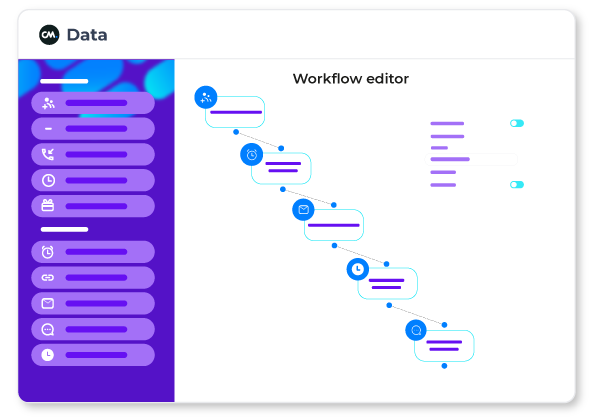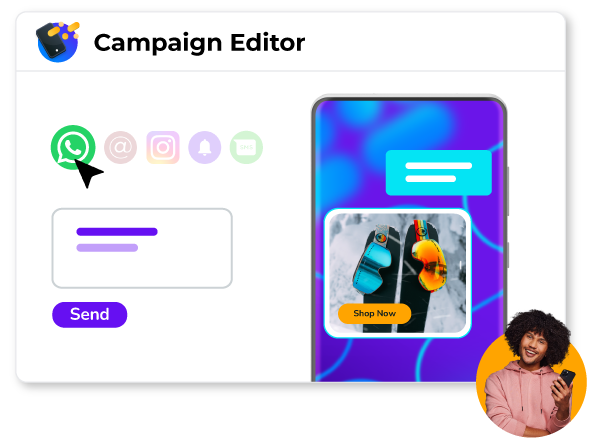- 1. What is a Customer Data Platform?
- 2. What You Can Accomplish With Customer Data.
- Act on untapped insights into customers
- Outperform customer expectations
- 3. A CDP Puts Marketeers in Control
- 4. The Types of Data Inside a CDP
- 5. Four Problems a CDP can solve
- Problem 1: No single customer view
- Problem 2: Loss of valuable customers
- Problem 3: Unreliable and untrustworthy data
- Problem 4: Lack of personalization
- 6. CDP vs DMP vs CRM
- CDP vs CRM
- CDP vs DMP
- 7. Types of CDPs
- Standalone CDP
- Customer engagement CDP
- 8. Use Cases of a CDP
- 1. Connect all offline and online touchpoints
- 2. Build smart customer segments and personalize
- 3. Recommend products and services
- 4. Enhance your online advertising audiences
- 5. Automate omnichannel marketing
- 6. Analytics - data-informed marketing
- Checklist: How to choose a CDP in 5 steps
- Why choose Mobile Marketing Cloud as your new CDP?
If you’re in marketing, you will have heard the term Customer Data Platform (CDP). CDPs have recently received a lot of hype in tech and marketing publications — despite being one of the more mysterious pieces of software to businesses across the sectors. Growing year on year, MarketsandMarkets report that the global CDP market is expected to reach 10.3 billion dollars by 2025.
But what exactly is a CDP and what is your marketing missing without one? We’re here to tell you in this introductory guide to customer data platforms.
1. What is a Customer Data Platform?
A CDP or Customer Data Platform is a software that collects customer touchpoints and interactions with your product or service from various channels and sources. It aggregates all this data from multiple sources to create a unified profile of each customer.
A Customer Data Platform is packaged software that creates a persistent, unified customer database that is accessible to other systems.
In essence, a CDP has three fundamental properties:
Packaged software: A CDP is a prebuilt system, configured to meet the needs of each client. Some technical resources will be required to set up and maintain the CDP, but it does not require the level of technical skill of a typical data warehouse project. This reduces the time, cost, and risk and gives business users more control over the system, even though they may still need some technical assistance.
Persistent, unified customer database: It collects customer data from multiple sources: creating a unified, complete view of each customer. CDPs pool and track customer data, such as behavioral data and demographics, and use this data to create a 360-degree view of each customer.
Accessible to other systems: It has the ability to share this data with other platforms. This is a particular asset when it comes to enhancing customer management and creating highly targeted, personalized marketing campaigns.
2. What You Can Accomplish With Customer Data.
Act on untapped insights into customers
Despite collecting extensive customer data, most companies are not equipped to create a unified, comprehensive view of each customer. Nor can they easily share this data across different systems. For most companies, customer data sits untapped across multiple systems. This means that most marketing teams only have a fraction of the insight they could have into their customer base — impacting their ability to granularly target and personalize their marketing initiatives.
Outperform customer expectations
The stakes are high in the modern-day customer journey. Customers expect easy, frictionless interactions with your company on every channel. This demands that you know who they are and what they’re doing. By recording all interactions they’ve had with your team, you know where they are in the customer journey, and how to respond. Outperform your customers’ expectations by giving relevant recommendations and providing the best service.
Also read: Why You Need a Customer Data Platform? >
3. A CDP Puts Marketeers in Control
Alternative solutions like data warehouses and data lakes are able to ingest data from multiple sources too. However, there is one important difference with a CDP: setting up and using these types of systems requires more advanced technical skills such as knowledge of SQL and other programming languages. This impacts their usability for most marketers.

Unlike traditional architecture, CDPs are designed to collect, organize, and share data easily across different systems. CDPs generally have a userfriendly interface that does not involve any programming code. As such, CDPs enable marketers to take control of data unification and analysis. CDPs enable marketers to efficiently use customer data to lead targeted, omnichannel marketing campaigns that excel.
4. The Types of Data Inside a CDP
Unlike most database software, CDPs are designed to seamlessly manage large volumes of ever-changing customer data. This data may include:
BASIC CUSTOMER DATA such as a customer’s name, age, and contact details
BEHAVIORAL DATA such as a user’s journey across a website or in a mobile app
BUYING BEHAVIORS including information on products they’ve bought or returned
DATA FROM CUSTOMER SERVICE INTERACTIONS such as a chatbot, email, or phone-call transcripts or information stored on your customer relationship management systems
DATA ANALYTICS FROM PAST CAMPAIGNS such as click-through-rates and engagement
5. Four Problems a CDP can solve
Problem 1: No single customer view
Without CDPs, customer data exists in separate systems and databases. For example, a telephone number may be in a CRM system, but the online purchases are only in the e-commerce platform. These systems are popularly known as “information silos” or “data silos” because they don’t communicate with each other to resolve duplicate and conflicting datapoints. Using them will result in customers receiving mixed messages. The opposite of a cohesive customer experience.

Whether it is service or sales, customers expect you to recognize them in every interaction. This lack of single customer view can have devastating impacts on a company’s bottom line: PWC reports that 59% of customers say they are willing to walk away from their favorite brand after a number of bad customer service experiences. Storing customer data separately ensures you lack the visibility you need to meet those expectations from your customers.
According to a recent survey entitled, ‘Best Practices in Building a Unified Customer Database’, 70% of companies rated a single customer view as “very important” or “extremely important”, but only 14% used a shared customer database.
CDPs were designed to remedy this lack of a single customer view by integrating data from a range of sources and using it to create a single comprehensive view of each customer.
Problem 2: Loss of valuable customers
By loss of customers, we mean customers who don’t come back or cancel. This is also known as the churn rate. The churn rate is especially important for companies that have many returning customers and, for example, sell subscriptions. For these companies, retaining existing customers is more important than acquiring new ones.
It costs five times as much to win a new customer, as it does to keep an existing one. While increasing customer retention rates by 5% increases a company’s profits by 25%-95%.
Repeat customers are extremely valuable, generating a substantial amount of a company’s revenue. As such, marketing teams are often directed to assign them prime importance. But that’s difficult to do without a single customer point of view. Thanks to their ability to collect and store data on customer buying behaviors, CDPs can identify repeat customers — especially high-value repeat customers that have spent a certain amount with a company.
The data stored by a CDP can also be used for targeted, omnichannel marketing campaigns, designed to engage these customers across every touchpoint. Marketers who put omnichannel campaigns into play have a roughly 90% higher retention rate than those running single-channel campaigns.
Bad customer experiences typically lead to high-churn rates. Satrix note that a high-annual churn rate can cost companies up to 50% of their potential revenue. Moreover, according to Esteban Kolsky - CEO of ThinkJar, 67% of customers churn because of a poor experience.
However, without tracking a customer’s experience across different channels, it’s nearly impossible to track the negative experiences that are pushing a customer towards cutting ties.
To illustrate, an easy way to increase customer satisfaction is by quickly resolving any complaints. However, complaints can be made in a variety of ways, such as in the form of a bad review or an in-store return.
Unfortunately, when these complaints are collected in different systems, they are hardly noticed. CDPs address this issue by ensuring a single customer view that tracks customers interactions and triggers alarms following any negative customer experiences — tackling high churn.
Moreover, CDPs can also be used to track and measure another common sign that a customer will churn over the next few months: lack of activity. By measuring a lack of activity, or a customer’s ‘silent complaints’, CDPs can be a powerful tool in helping you to predict and prevent churn.
Beyond tracking and notifying, the real value of a CDP lies in its ability to automate the delivery of support messages to any dissatisfied customer, as well as its capacity to automatically notify one of your customer service agents to reach out to the customer in question.
Problem 3: Unreliable and untrustworthy data
Both first and third-party data are commonly used to drive marketing campaigns. However, first-party data is more valuable, dependable, and less risky than third-party data. Customer data platforms are primarily engineered to focus on owned and trusted first-party data.
As data collected directly from your customers, first-party data is the least risky because you are aware of its source and own it outright. It allows for targeted, personalized marketing initiatives that typically offer far better results.
In comparison, third-party data is collected from multiple sources and often comes from unknown, unverifiable sources. While you can ensure that you store and manage your data in compliance with regulations like GDPR, it is far harder to verify whether third-party vendors are doing the same.
Third-party data that comes in the form of purchased, external lists of contacts or audiences can be unreliable and of questionable quality. For example, Mediasmith research found that data from four of 11 vendors did not rank any better than chance when it came to identifying and targeting customers based on age and gender.
Moreover, third-party data in the form of audiences and campaign data utilized on platforms such as Facebook and Google, is never owned outright by the account user. If the platform you are using decides to suspend its service or suspend your account, you lose the data.
In addition, third-party data may also have been poorly aggregated and can be difficult to integrate with existing data. In contrast, when it comes to integrating third-party datasets when needed, CDPs emphasize quality control and integration at scale.
Problem 4: Lack of personalization
Personalization is a big marketing buzzword, but it can be next to impossible to achieve without a strong omnichannel strategy that delivers a personalized experience to customers as they move between touchpoints — from app to desktop, from laptop to store. A lack of personalization can make customers feel unvalued. The single customer view delivered by CDPs ensures that every interaction with a brand can be tailored to each customer.
Tom van den Tillaer, manager of Brennan Heart highlights how the team uses CM.com’s CDP to personalize customer interactions, “The great thing about CM.com’s CDP is that you can segment very easily. For example, you can select all Spanish people in just two clicks. Then change the language in the email or SMS you send and give information about the tour in Spain. This makes the communication more personal and unique. By choosing a segment, you also exclude all irrelevant people.”
It’s automated two-way traffic. The Facebook bot, for example, is designed to provide an automated answer to a fan’s question. So, it really feels like a fan is having a conversation with Brennan Heart.

6. CDP vs DMP vs CRM
By now you might be wondering “what if I already have a CRM or DMP?”. The short version is that a Customer Data Platform (CDP) does not replace either, but acts complimentary. The best way to explain the differences is to take a look at the history of these solutions and the problems they intended to solve.
Online Customer Relationship Management (CRM) software entered the market in 1997 and was designed to enable companies to easily manage their relationship with leads and customers. CRMs collect first-party data on known prospects and customers — enabling businesses to nurture leads, manage and retain customers more effectively, and support collaboration within sales teams. Vulnerable to human error, the data inside a CRM is only as good as the input and maintenance of the sales reps and account managers who use it.
Utilized by professionals in advertising, focused on building awareness — with visibility and impressions as their driving KPIs, Data Management Platforms (DMPs) hit the market in the 2000s. In the early 2000s, DMPs were exclusively used by digital advertising buyers and publishers — looking to store and manage audience data from a range of sources and use this data to create advertising segments. DMPs process and organize second and third-party data, they are predominantly cookie-based and use anonymous IDs for profiles.
The next in line, Customer Data Platforms arrived to directly combat the data silos created by DMPs and CRMs. CDPs combine a company’s first party, second party, and third-party data — including data from point-of-sale systems, IoT devices, loyalty applications, CRMs, and DMPs. CDPs then combine this data to create unique customer profiles that provide an in-depth, 360˚look at each customer. CDPs are typically utilized to deliver personalized customer experiences and targeted, omnichannel marketing campaigns.
CDP vs CRM
Despite the fact that both CDPs and CRMs collect and store customer data, they have several distinct differences:
CDPs collect data on anonymous visitors, while CRMs only provide data on known customers or potential customers.
CDPs can be used to track online and offline customer data. CRMs can track offline data if it is entered manually or via an integration, but this ability is never native to a CRM in the way it is with a CDP.
CDPs can be used to analyze lifetime customer behavior and customer journeys, whereas CRMs predominantly analyze the sales pipeline.
CDPs are designed to manage and integrate a large volume of data from multiple sources — ensuring it is securely integrated and stored. In contrast, CRMs collect individually entered data that’s vulnerable to loss and misidentification.
CDP vs DMP
David Raab, founder of the CDP Institute, succinctly covers the difference between CDPs and Data Management Platforms (DMPs), he states: “CDPs work with both anonymous and known individuals, storing ‘personally identifiable information’ such as names, postal addresses, email addresses, and phone numbers, while DMPs work with almost exclusively with anonymous entities such as cookies, devices, and IP addresses.”
CDPs can be used in all kinds of marketing, whereas DMPs are typically used in advertising in order to target ads more effectively and reach new audiences.
CDPs predominantly collect high-quality, first-party data, while DMPs mostly collect thirdparty data — such as the data acquired through data providers, managers, and services.
CDPs collect personalized customer identifiers — such as a customer’s name and contact details. In comparison, DMPs only store anonymous customer identifiers, such as cookies.
CDPs are designed to create thorough, accurate customer profiles. As such, they retain data over a long period of time. In comparison, because DMPs are designed to target ads and reach new audiences, they only retain data for a short period of time. This is down to the fact that when you purchase data like an audience list you enter into an agreement to only use this data for a specified time period.
Read more in our blog: CRM, CDP and DMP Platforms: How Are They Different?
7. Types of CDPs
It’s important to understand the different types of Customer Data Platforms to find the solution that best fits your needs. Below, we compare Standalone CDPs to Customer Engagement CDPs.
Standalone CDP
A standalone CDP has one job: to integrate a company’s first-party customer data and turn this data into a comprehensive, 360-degree view of each customer. You can use a standalone CDP to create segments and share customer data with your other systems, but you’ll need other software to fully execute marketing and customer engagement campaigns. The most obvious one being email campaign software, but don’t forget landing page builders or mobile messaging channels.
Often times there are ready to use integrations present for the most popular marketing solutions. But in case these are not available for software you are already using, all CDPs offer APIs to make your own integrations. A standalone CDP makes sense for companies that already have marketing campaign software, have development capacity available and are just looking for ways to unify their customer data.
Customer engagement CDP
Great as an all-round solution that can also be easily integrated into your tech stack, a customer engagement CDP is the same as a standalone CDP but with extra marketing capabilities built in.
CM.com’s Mobile Marketing Cloud is a great example of a Customer Engagement CDP that allows you to centralize your customer data, create enhanced customer segments for greater relevancy, refine your omnichannel marketing campaigns with real-time data and analytics, and automate your customer journeys across every channel — from email to mobile.

For those who are considering to replace a bigger part of their marketing technology stack with one solution, a Customer Engagement CDP is probably more efficient. The implementation is simpler and quicker, because developers are not needed to tie all the systems together.
8. Use Cases of a CDP
1. Connect all offline and online touchpoints
CDPs bring together all of your data, including data from your CRM, DMP, loyalty applications, point of sale systems, and IoT devices to create holistic customer profiles that reflect customers’ entire interactions with your company. This enables you to remember a customer and personalize every interaction with them, whether they are in store, at their desktop, or on mobile.
2. Build smart customer segments and personalize
CDPs enable you to integrate customer data from different channels and transform this data into real-time, actionable customer segments. You can create smart customer segments based on as many rules and filters as you like, make them as granular and complex as you need — or just keep your segments simple. No matter your approach, you have extensive options available to make your communication more relevant and personal to your customers.
3. Recommend products and services
Increase your average order value by powering recommendation models with real-time customer data. Netflix, YouTube, and Amazon algorithms are all great examples of this at play — always recommending people the next best thing to watch or buy.
4. Enhance your online advertising audiences
Most CDPs can be integrated with the big online advertising platforms, from Google to Facebook, and used to retarget your audiences and create lookalike audiences for more impactful advertising. Retargeting based on website activity is common, by tracking pixels from the ad platforms, but retargeting based on offline events and other systems integrated with your site is something only a CDP can do.
5. Automate omnichannel marketing
Use data on customer behaviors, such as interactions with your site and purchase history, to create customer profiles that power a personalized, omnichannel marketing strategy. By tracking a customer’s journey across every platform, you can automate personalized marketing messages that increase your conversion and customer retention rates. Because CDP’s already have connections with many systems in order to collect data, they can easily track customers across every single channel. Moreover, CDPs can also be the starting point for sending automated messages to customers over each channel. While most marketing automation tools only focus on e-mail, a CDP can potentially do much more. Automating text messages, pre-recorded voice calls, WhatsApp messages, and more.
6. Analytics - data-informed marketing
CDPs offer rich customer data that can be used to create data-informed hypotheses about what customers want and need based on prior behavior. In addition, real-time customer data can also be used to test, evaluate, and optimize marketing campaigns.
Checklist: How to choose a CDP in 5 steps
If you’ve decided a CDP would make a great addition to your martech stack, it’s time to ask the question: How do I choose the right vendor for me? In order to make the best choice, you need to ask these five questions:
✅ 1. FRAME YOUR VENDOR RESEARCH WITH YOUR USE CASES IN MIND
Based on the above use cases, reflect on how a CDP can fit into your current business needs. Will you use your CDP to understand and optimize the customer journey across different channels? Do you need a tool that can unify your customer information and combat data silos? Are you looking for a tool to help you create more granular customer segments? Consider whether a Standalone CDP or an enhanced CDP would best suit your needs and your budget.
✅ 2. CONSIDER WHETHER YOU’LL NEED SUPPORT WITH IMPLEMENTATION
Assess whether you have the required capacity in-house to undertake implementation and connect your systems. CDPs typically require advanced technical skills to implement. Based on this assessment, you might need to look for a vendor who can assist with the task — some vendors offer extensive support with integration, while others do not.
Unlike many other CDP providers that work with third-party companies to assist with implementation, CM.com provide in-house consultants to help every client implement CM.com’s Mobile Marketing Cloud.
✅ 3. CONSIDER USABILITY
Does the CDP you’re considering require advanced technical skills? Do you have someone in the team who can use it with ease? To ensure usability, we return to the importance of always requesting a demo before you buy.
✅ 4. ASK FOR A DEMO
Who can best meet the needs of your team? Make a list of vendors that could fit your requirements. Next, contact the company and discuss their experience with similar use cases and ask them to show you their solution with a demo.
✅ 5. FOLLOW UP ON REFERRALS
You’ll only know how well a CDP really performs by speaking with a provider’s customers. Ask for referrals and dive deep into their experiences with the brand and solution. We recommend you come prepared with questions on usability, data integration, the quality of customer profiles and segmentations, ROI, and customer support.
Why choose Mobile Marketing Cloud as your new CDP?
There are a lot of CDP’s in the world, but Mobile Marketing Cloud is unique because it’s the only platform that is completely mobilefocused — with mobile landing pages and the native integrated mobile channels. Email, SMS, Push, WhatsApp, Apple Business Chat, and Voice are all built-in and can be used immediately, without any programming. Entirely homegrown, every element of the platform was built to work together. This means faster integrations, smooth operation, and better results.
Many of our users have large amounts of data, but their core business is not digital. Their customer data is generated across multiple systems that have no marketing & communication capabilities. Our Customer Data Platform seamlessly connects those systems and creates unified customer profiles — ready to use for marketers, enabling them to provide richer customer experiences and improve customer engagement.
